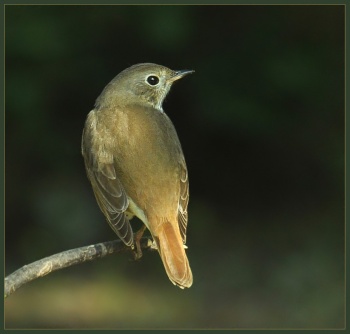- Catharus guttatus
Identification
16–18 cm (6¼-7.5 in)
Small. As with other Catharus thrushes, underwing has white dark white pattern. Breast only sparsely and sparingly spotted, but spots are large. Flanks usually entirely unspotted. Grey-brown above, with rusty-red tone to rump and tail (like Nightingale, but is slightly bigger, more compact and shorter-tailed than that species, besides other plumage differences). White eye-ring. Easily identified with sound. Song is a haunting low pitched whstle that ascends into a high pitched echo. Often sings in the morning and evening.
Distribution
Breeds in southern Alaska and across Canada to Newfoundland, south to California in the west and Maryland in the east.
Leaves breeding areas late September-early November and winters from the southern part of the breeding range south to Central America, returning in early April-May.
In the Western Palearctic recorded in Iceland, the British Isles, Sweden and Germany, as well as 3 old records from Luxembourg. British records mainly on Shetland and Scilly in October but also recorded in spring.
Taxonomy
Subspecies
This is a polytypic species, consisting of 9 subspecies1 (although more are recognized by other authorities)2:
- C. g. auduboni - breeds in Rocky Mountains of south-western US to New Mexico; winters to Guatemala
- C. g. crymophilus - breeds in Newfoundland; winters to south-eastern US
- C. g. faxoni - breeds in the Yukon and northern Canada to eastern US; winters to Florida
- C. g. guttatus - breeds in the Alaskan Peninsula to south-western Canada; winters to central Mexico
- C. g. nanus - breeds Coastal south-eastern Alaska and western British Columbia; winters to Baja California
- C. g. polionotus - breeds Eastern Washington to east-central California, Nevada and south-western Utah
- C. g. sequoiensis - breeds Sierra Nevada of California and western Nevada; winters to northern Mexico
- C. g. slevini - breeds Washington and Oregon to central California; winters to north-western Mexico
- C. g. vaccinius - breeds Vancouver Island; winters to coastal central California
A study shows genetic divisions within this species possibly indicating a future split3.
Habitat
Coniferous and mixed forest from wet lowlands to 300m in mountains. In winter often in drier situations, also gardens and town parks.
Behaviour
Often jerks tail upwards and slowly lowers it.
Diet
During spring and summer their diet consists mainly of insects such as beetles, caterpillars, bees, ants, wasps, and flies. In the autumn and winter they switch to fruit and berries.
Breeding
The nest is built by the female and generally placed either in a low bush or on the ground. It is constructed from grass, leaves and pine needles; lined with soft plant materials. The clutch consists of 3-6 pale blue eggs which are incubated for 11-13 days; fledging occurs after about 10-15 days. There may be a second brood.
Vocalisation
A very musical sound that is one of the most beautiful bird sounds in the world. Sounds like an unknown musical instrument.
References
- Clements, J. F., T. S. Schulenberg, M. J. Iliff, D. Roberson, T. A. Fredericks, B. L. Sullivan, and C. L. Wood. 2018. The eBird/Clements checklist of birds of the world: v2018. Downloaded from http://www.birds.cornell.edu/clementschecklist/download/
- Avibase
- Paper describing genetic findings with this species
- Handbook of the Birds of the World Alive (retrieved Aug 2018)
Recommended Citation
- BirdForum Opus contributors. (2025) Hermit Thrush. In: BirdForum, the forum for wild birds and birding. Retrieved 1 May 2025 from https://www.birdforum.net/opus/Hermit_Thrush
External Links
GSearch checked for 2020 platform.1






